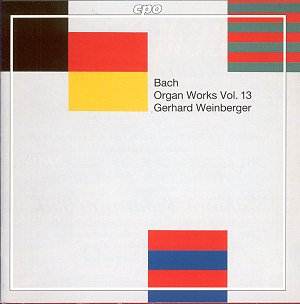This thirteenth volume in CPO's comprehensive survey
of Bach's organ music features Gerhard Weinberger at the organ of the
Grauhof Monastery, near Goslar. As ever there is an imaginatively planned
programme of music from the Third Part of the Clavierübung, beginning
with the E flat Prelude and then the Fugue, interspersed with a collection
of chorale preludes. However, I have to confess that when listening
I was drawn to re-programme the player in order to hear the Prelude
and Fugue together.
The booklet notes are thorough and well written, and
give full explanations of what is done and the reasons why it is done.
And since we have the technology, why not use it when deciding what
we will listen to and when?
The recording engineers have captured the music in
a pleasing acoustic, although not as sonically impressive as in some
other recordings in the series. Even so, the music still makes a strong
impression. Weinberger is an experienced artist and he understands this
repertoire, choosing his tempi wisely. He also succeeds in conveying
the personalities of the shorter chorale preludes which form the central
part of the programme. These more intimate aspects of Bach's organ works
can cause acoustic difficulties in recordings, but this is never a problem
here. This is playing of artistry and sensitivity to be sure.
The Prelude and Fugue in E flat major is a substantial
composition, of some sixteen minutes duration. It is commonly known
in England as the 'St Anne' (though not in the documentation of this
CD), because of the similarity between Bach's fugue subject and the
first line of the hymn tune 'St Anne', probably composed by William
Croft (1678-1727), to which the first line 'O God, our help in ages
past' is sung. It is not thought that Bach was familiar with the hymn,
however, so the similarity is merely a coincidence. Be that as it may,
Weinberger performers the music with the utmost assurance, though (see
comments above) the decision to spread the Prelude and the Fugue either
side of the chorale preludes does rob the complete work of some of its
majesty. It is better, on balance, to indulge the opportunity to reconnect
the two.
The documentation is excellent, with full details of
the instrument as well as the music. As usual from this source, the
English translation occasionally reads a little oddly, but generally
the production standards are very high. This is true also of the recorded
sound and the performances by this fine organist.
Terry Barfoot
see also review by Chris Howell
